Vignesh Gopakumar
UK Atomic Energy Authority, Culham Science Centre, Abingdon, UK
Calibrated Physics-Informed Uncertainty Quantification
Feb 06, 2025Abstract:Neural PDEs offer efficient alternatives to computationally expensive numerical PDE solvers for simulating complex physical systems. However, their lack of robust uncertainty quantification (UQ) limits deployment in critical applications. We introduce a model-agnostic, physics-informed conformal prediction (CP) framework that provides guaranteed uncertainty estimates without requiring labelled data. By utilising a physics-based approach, we are able to quantify and calibrate the model's inconsistencies with the PDE rather than the uncertainty arising from the data. Our approach uses convolutional layers as finite-difference stencils and leverages physics residual errors as nonconformity scores, enabling data-free UQ with marginal and joint coverage guarantees across prediction domains for a range of complex PDEs. We further validate the efficacy of our method on neural PDE models for plasma modelling and shot design in fusion reactors.
Guaranteed confidence-band enclosures for PDE surrogates
Jan 30, 2025



Abstract:We propose a method for obtaining statistically guaranteed confidence bands for functional machine learning techniques: surrogate models which map between function spaces, motivated by the need build reliable PDE emulators. The method constructs nested confidence sets on a low-dimensional representation (an SVD) of the surrogate model's prediction error, and then maps these sets to the prediction space using set-propagation techniques. The result are conformal-like coverage guaranteed prediction sets for functional surrogate models. We use zonotopes as basis of the set construction, due to their well studied set-propagation and verification properties. The method is model agnostic and can thus be applied to complex Sci-ML models, including Neural Operators, but also in simpler settings. We also elicit a technique to capture the truncation error of the SVD, ensuring the guarantees of the method.
Uncertainty Quantification of Pre-Trained and Fine-Tuned Surrogate Models using Conformal Prediction
Aug 19, 2024Abstract:Data-driven surrogate models have shown immense potential as quick, inexpensive approximations to complex numerical and experimental modelling tasks. However, most surrogate models characterising physical systems do not quantify their uncertainty, rendering their predictions unreliable, and needing further validation. Though Bayesian approximations offer some solace in estimating the error associated with these models, they cannot provide they cannot provide guarantees, and the quality of their inferences depends on the availability of prior information and good approximations to posteriors for complex problems. This is particularly pertinent to multi-variable or spatio-temporal problems. Our work constructs and formalises a conformal prediction framework that satisfies marginal coverage for spatio-temporal predictions in a model-agnostic manner, requiring near-zero computational costs. The paper provides an extensive empirical study of the application of the framework to ascertain valid error bars that provide guaranteed coverage across the surrogate model's domain of operation. The application scope of our work extends across a large range of spatio-temporal models, ranging from solving partial differential equations to weather forecasting. Through the applications, the paper looks at providing statistically valid error bars for deterministic models, as well as crafting guarantees to the error bars of probabilistic models. The paper concludes with a viable conformal prediction formalisation that provides guaranteed coverage of the surrogate model, regardless of model architecture, and its training regime and is unbothered by the curse of dimensionality.
Valid Error Bars for Neural Weather Models using Conformal Prediction
Jun 20, 2024
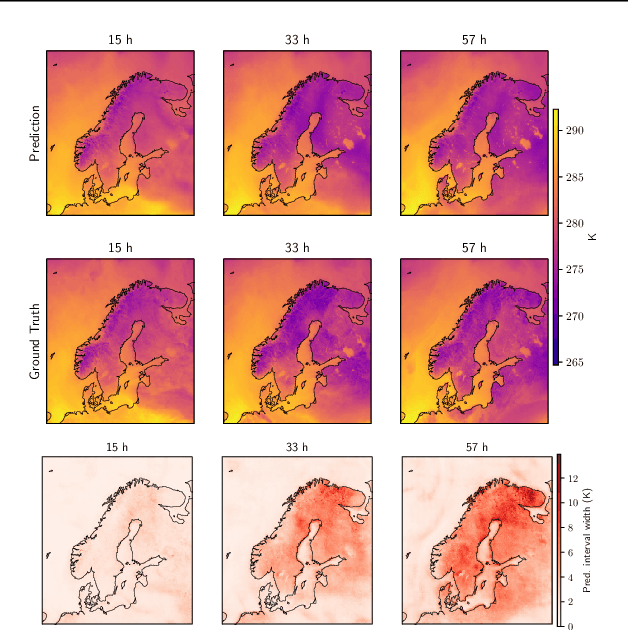
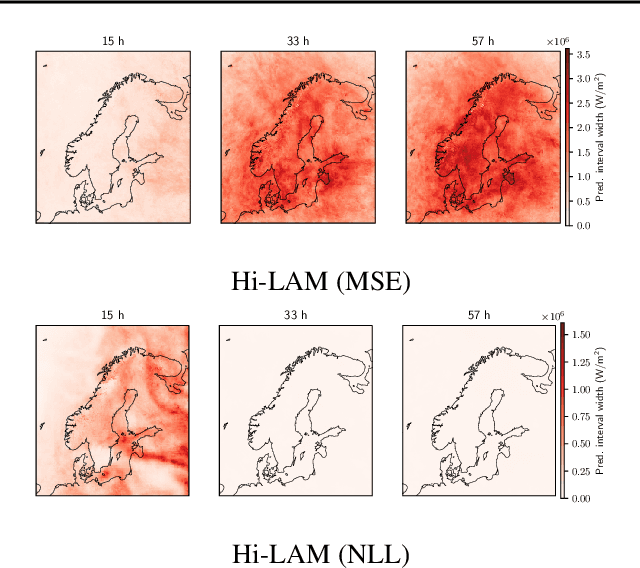
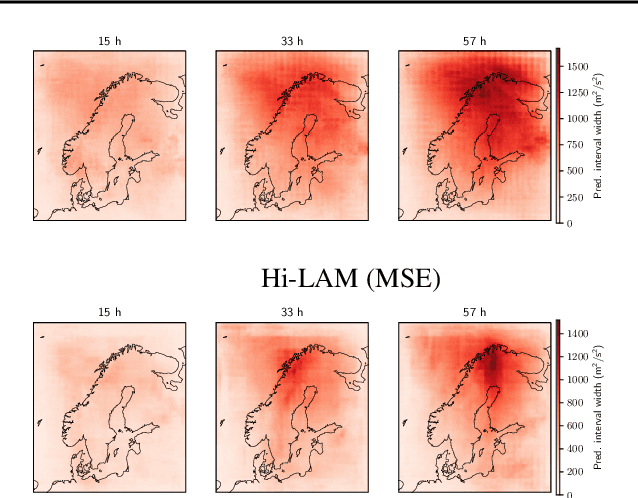
Abstract:Neural weather models have shown immense potential as inexpensive and accurate alternatives to physics-based models. However, most models trained to perform weather forecasting do not quantify the uncertainty associated with their forecasts. This limits the trust in the model and the usefulness of the forecasts. In this work we construct and formalise a conformal prediction framework as a post-processing method for estimating this uncertainty. The method is model-agnostic and gives calibrated error bounds for all variables, lead times and spatial locations. No modifications are required to the model and the computational cost is negligible compared to model training. We demonstrate the usefulness of the conformal prediction framework on a limited area neural weather model for the Nordic region. We further explore the advantages of the framework for deterministic and probabilistic models.
Plasma Surrogate Modelling using Fourier Neural Operators
Nov 10, 2023Abstract:Predicting plasma evolution within a Tokamak reactor is crucial to realizing the goal of sustainable fusion. Capabilities in forecasting the spatio-temporal evolution of plasma rapidly and accurately allow us to quickly iterate over design and control strategies on current Tokamak devices and future reactors. Modelling plasma evolution using numerical solvers is often expensive, consuming many hours on supercomputers, and hence, we need alternative inexpensive surrogate models. We demonstrate accurate predictions of plasma evolution both in simulation and experimental domains using deep learning-based surrogate modelling tools, viz., Fourier Neural Operators (FNO). We show that FNO has a speedup of six orders of magnitude over traditional solvers in predicting the plasma dynamics simulated from magnetohydrodynamic models, while maintaining a high accuracy (MSE $\approx$ $10^{-5}$). Our modified version of the FNO is capable of solving multi-variable Partial Differential Equations (PDE), and can capture the dependence among the different variables in a single model. FNOs can also predict plasma evolution on real-world experimental data observed by the cameras positioned within the MAST Tokamak, i.e., cameras looking across the central solenoid and the divertor in the Tokamak. We show that FNOs are able to accurately forecast the evolution of plasma and have the potential to be deployed for real-time monitoring. We also illustrate their capability in forecasting the plasma shape, the locations of interactions of the plasma with the central solenoid and the divertor for the full duration of the plasma shot within MAST. The FNO offers a viable alternative for surrogate modelling as it is quick to train and infer, and requires fewer data points, while being able to do zero-shot super-resolution and getting high-fidelity solutions.
Shaping of Magnetic Field Coils in Fusion Reactors using Bayesian Optimisation
Oct 02, 2023Abstract:Nuclear fusion using magnetic confinement holds promise as a viable method for sustainable energy. However, most fusion devices have been experimental and as we move towards energy reactors, we are entering into a new paradigm of engineering. Curating a design for a fusion reactor is a high-dimensional multi-output optimisation process. Through this work we demonstrate a proof-of-concept of an AI-driven strategy to help explore the design search space and identify optimum parameters. By utilising a Multi-Output Bayesian Optimisation scheme, our strategy is capable of identifying the Pareto front associated with the optimisation of the toroidal field coil shape of a tokamak. The optimisation helps to identify design parameters that would minimise the costs incurred while maximising the plasma stability by way of minimising magnetic ripples.
Fourier-RNNs for Modelling Noisy Physics Data
Feb 13, 2023Abstract:Classical sequential models employed in time-series prediction rely on learning the mappings from the past to the future instances by way of a hidden state. The Hidden states characterise the historical information and encode the required temporal dependencies. However, most existing sequential models operate within finite-dimensional Euclidean spaces which offer limited functionality when employed in modelling physics relevant data. Alternatively recent work with neural operator learning within the Fourier space has shown efficient strategies for parameterising Partial Differential Equations (PDE). In this work, we propose a novel sequential model, built to handle Physics relevant data by way of amalgamating the conventional RNN architecture with that of the Fourier Neural Operators (FNO). The Fourier-RNN allows for learning the mappings from the input to the output as well as to the hidden state within the Fourier space associated with the temporal data. While the Fourier-RNN performs identical to the FNO when handling PDE data, it outperforms the FNO and the conventional RNN when deployed in modelling noisy, non-Markovian data.
Loss Landscape Engineering via Data Regulation on PINNs
May 16, 2022
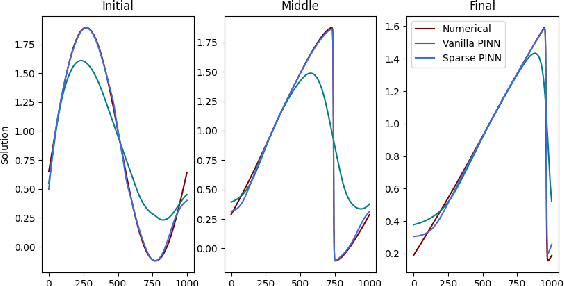


Abstract:Physics-Informed Neural Networks have shown unique utility in parameterising the solution of a well-defined partial differential equation using automatic differentiation and residual losses. Though they provide theoretical guarantees of convergence, in practice the required training regimes tend to be exacting and demanding. Through the course of this paper, we take a deep dive into understanding the loss landscapes associated with a PINN and how that offers some insight as to why PINNs are fundamentally hard to optimise for. We demonstrate how PINNs can be forced to converge better towards the solution, by way of feeding in sparse or coarse data as a regulator. The data regulates and morphs the topology of the loss landscape associated with the PINN to make it easily traversable for the minimiser. Data regulation of PINNs helps ease the optimisation required for convergence by invoking a hybrid unsupervised-supervised training approach, where the labelled data pushes the network towards the vicinity of the solution, and the unlabelled regime fine-tunes it to the solution.
Fast Regression of the Tritium Breeding Ratio in Fusion Reactors
Apr 08, 2021
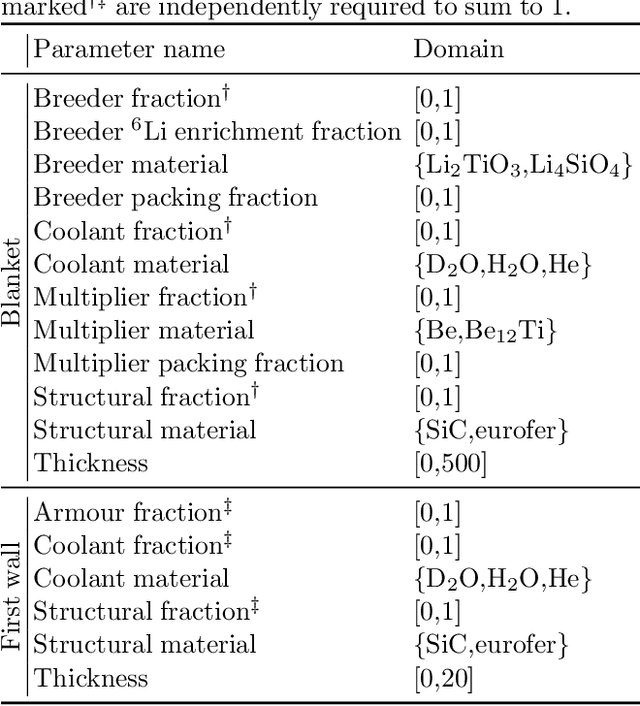
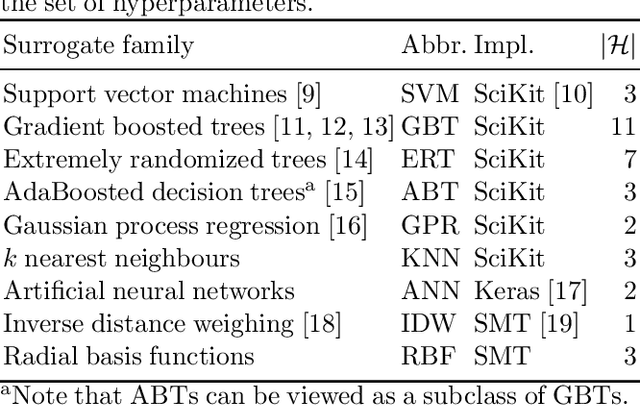
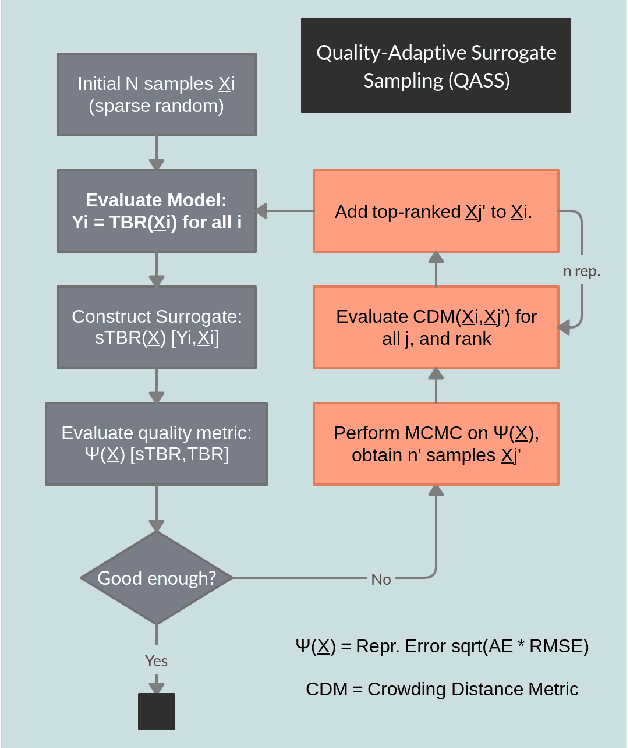
Abstract:The tritium breeding ratio (TBR) is an essential quantity for the design of modern and next-generation D-T fueled nuclear fusion reactors. Representing the ratio between tritium fuel generated in breeding blankets and fuel consumed during reactor runtime, the TBR depends on reactor geometry and material properties in a complex manner. In this work, we explored the training of surrogate models to produce a cheap but high-quality approximation for a Monte Carlo TBR model in use at the UK Atomic Energy Authority. We investigated possibilities for dimensional reduction of its feature space, reviewed 9 families of surrogate models for potential applicability, and performed hyperparameter optimisation. Here we present the performance and scaling properties of these models, the fastest of which, an artificial neural network, demonstrated $R^2=0.985$ and a mean prediction time of $0.898\ \mu\mathrm{s}$, representing a relative speedup of $8\cdot 10^6$ with respect to the expensive MC model. We further present a novel adaptive sampling algorithm, Quality-Adaptive Surrogate Sampling, capable of interfacing with any of the individually studied surrogates. Our preliminary testing on a toy TBR theory has demonstrated the efficacy of this algorithm for accelerating the surrogate modelling process.
 Add to Chrome
Add to Chrome Add to Firefox
Add to Firefox Add to Edge
Add to Edge